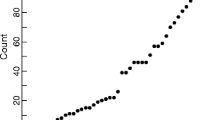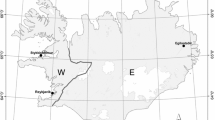Abstract
In this study, we use deterministic and stochastic models to analyze the demography of Verreaux’s sifaka (Propithecus verreauxi verreauxi) in a fluctuating rainfall environment. The model is based on 16 years of data from Beza Mahafaly Special Reserve, southwest Madagascar. The parameters in the stage-classified life cycle were estimated using mark-recapture methods. Statistical models were evaluated using information-theoretic techniques and multi-model inference. The highest ranking model is time-invariant, but the averaged model includes rainfall-dependence of survival and breeding. We used a time-series model of rainfall to construct a stochastic demographic model. The time-invariant model and the stochastic model give a population growth rate of about 0.98. Bootstrap confidence intervals on the growth rates, both deterministic and stochastic, include 1. Growth rates are most elastic to changes in adult survival. Many demographic statistics show a nonlinear response to annual rainfall but are depressed when annual rainfall is low, or the variance in annual rainfall is high. Perturbation analyses from both the time-invariant and stochastic models indicate that recruitment and survival of older females are key determinants of population growth rate.







Similar content being viewed by others
References
Alberts SC, Altmann J (2003) Matrix models for primate life history analysis. In: Kappeler PM, Pereira ME (eds) Primate life histories and socioecology. University of Chicago Press, Chicago, pp 66–102
Anderson DR (2008) Model based inference in the life sciences: a primer on evidence. Springer, New York
Brault S, Caswell H (1993) Pod-specific demography of killer whales (Orcinus orca). Ecology 74:1444–1454
Brockman DK, Dollar LJ, Godfrey LR (2008) Evidence of wildcat (Felis silvestris) predation on Propithecus verreauxi at Beza Mahafaly, Madagascar. Int J Primatol 29:135–152
Burnham KP, Anderson DR (2002) Model selection and multimodel inference. A practical information theoretic approach. Springer, Berlin
Caswell H (1982) Life history theory and the equilibrium status of populations. Am Nat 120:317–339
Caswell H (2001) Matrix population models. Sinauer, Sunderland
Caswell H (2005) Sensitivity analysis of the stochastic growth rate: three extensions. Aust NZ J Stat 47:75–85
Caswell H (2006) Applications of Markov chains in demography. In: Langville AN, Stewart WJ (eds) MAM2006: Markov Anniversary Meeting. Boson Books, Raleigh, pp 319–334
Caswell H, Fujiwara M (2004) Beyond survival estimation: mark-recapture, matrix population models, and population dynamics. Anim Biodiv Cons 27:471–488
Caswell H, Takada T, Hunter CM (2004) Sensitivity analysis of equilibrium in density-dependent matrix population models. Ecol Lett 7:380–387
Choquet R, Reboulet A-M, Lebreton J-D, Gimenez O, Pradel R (2005) U-Care 2.2 user’s manual. CEFE, Montpelier
Coale AJ (1972) The growth and structure of human populations: a mathematical approach. Princeton University Press, Princeton
Cowlishaw G, Dunbar RIM (2000) Primate conservation biology. University of Chicago Press, Chicago
Crouse DT, Crowder LB, Caswell H (1987) A stage-based population model for loggerhead sea turtles and implications for conservation. Ecology 68:1412–1423
Cushing JM, Yicang Z (1994) The net reproductive value and stability in matrix population models. Nat Res Mod 8:297–333
Dewar RE, Wallis JR (1999) Geographical patterning of interannual rainfall variability in the tropics and near tropics: an L-moments approach. J Clim 12:3457–3466
Dewar RE, Richard AF (2007) Evolution in the hypervariable environment of Madagascar. Proc Natl Acad Sci USA 104:13723–13727
Dobson AP, Lyles AM (1989) The population dynamics and conservation of primate populations. Cons Biol 3:362–381
Efford M (2001) Environmental stochasticity cannot save declining populations. Trends Ecol Evol 16:177
Fujiwara M, Caswell H (2002) Estimating population projection matrices from multi-stage mark-recapture data. Ecology 83:3257–3265
Gage TB (1998) The comparative demography of primates: with some comments on the evolution of life histories. Annu Rev Anthropol 27:197–221
Ganzhorn JU (1995) Cyclones over Madagascar: fate or fortune? Ambio 24:124–125
Godfrey LR, Samonds KE, Jungers WL, Sutherland MR, Irwin MT (2004) Ontogenetic correlates of diet in Malagasy lemurs. Am J Phys Anthropol 123:250–276
Gould L, Sussman RW, Sauther ML (1999) Natural disasters and primate populations: the effects of a 2-year drought on a naturally occurring population of ring-tailed lemurs (Lemur catta) in southwestern Madagascar. Int J Primatol 20:69–84
Gould L, Sussman RW, Sauther ML (2003) Demographic and life-history patterns in a population of ring-tailed lemurs (Lemur catta) at Beza Mahafaly Reserve, Madagascar: a 15-year perspective. Am J Phys Anthropol 120:182–194.
Heyde CC, Cohen JE (1985) Confidence intervals for demographic projections based on products of random matrices. Theor Pop Biol 27:120–153
Hoerling MP, Hurrell JW, Eischeid J (2006) Detection and attribution of 20th century northern and southern African monsoon change. J Clim 19:3989–4008
Hudson DA, Jones RG (2002) Regional climate model simulations of present-day and future climates of southern Africa. Hadley Centre Tech Note 39:1–42
Hunter CM, Caswell H, Runge MC, Regehr EV, Amstrup SC, Stirling I (2007) Polar bears in the southern Beaufort Sea. II. Demography and population growth in relation to sea ice conditions. U.S.G.S. administrative report, 1–42
Jolly A, Dobson A, Rasamimmanana HM, Walker J, O’Connor S, Solberg M, Perel V (2002) Demography of Lemur catta at Berenty Reserve, Madagascar: effect of troop size, habitat, and rainfall. Int J Primatol 23:327–353
Kappeler PM (1996) Causes and consequences of life history variation among strepsirhing primates. Am Nat 148:868–891
King SJ, Arrigo-Nelson SJ, Pochron ST, Semprebon GM, Godfrey LR, Wright PC, Jernvall J (2005) Dental senescence in a long-lived primate links infant survival to rainfall. Proc Nat Acad Sci USA 102:16579–16583
Lande R (1982) A quantitative genetic theory of life history evolution. Ecology 63:607–615
Lebreton J-D, Burnham KP, Clobert J, Anderson DR, (1992) Modeling survival and testing biological hypotheses using marked animals: a unified approach with case studies. Ecol Monogr 62:67–118
Mittermeier RA, Konstant WR, Hawkins F, Louis EE, Langrand O, Ratsimbazafy J, Rasoloarison R, Ganzhorn JU, Rajaobelina S, Tattersall I, Meyer DM (2006) Lemurs of Madagascar. (Tropical field guide series) Conservation International, Washington DC
Mood AM, Graybill FA, Boes DC (1974) Introduction to the theory of statistics. McGraw Hill, New York
Morris WF, Pfister CA, Tuljajurkar S, Haridas CV, Boggs CL, Boyce MS, Bruna EM, Church DR, Coulson T, Doak DF, Forsyth S, Gaillard J-M, Horvitz CC, Kalisz S, Kendall BE, Knight TM, Lee CT, Menges ES (2008) Longevity can buffer plant and animal populations against changing climatic variability. Ecology 89:19–25
Pradel R, Gimenez O, Lebreton J-D (2005) Principles and interest of GOF tests for multistate capture-recapture models. Anim Biodiv Cons 28:189–204
Pochron ST, Tucker WT, Wright PC (2004) Demography, life history, and social structure in Propithecus diadema edwardsi from 1986-2000 in Ranomafana National Park, Madagascar. Am J Phys Anthropol 125:61–72
Raisanen J (2002) CO2-induced changes in interannual temperature and precipitation variability in 19 CMIP2 experiments. J Clim 15:2395–2411
Richard AF, Dewar RE (1990) Lemur ecology. Annu Rev Ecol Syst 22:145–175
Richard AF, Dewar RE, Schwartz M, Ratsirarson J (2000) Mass change, environmental variability and female fertility in wild Propithecus verreauxi. J Hum Evol 39:381–391
Richard AF, Dewar RE, Schwartz M, Ratsirarson J (2002) Life in the slow lane? Demography and life histories of male and female sifaka (Propithecus verreauxi verreauxi). J Zool 256:421–436
Ripley BJ, Caswell H (2006) Recruitment variability and stochastic population growth of the soft-shell clam Mya arenaria. Ecol Mod 193:517–530
Sauther ML (1998) Interplay of phenology and reproduction in ring-tailed lemurs: implications for ring-tailed lemur conservation. Folia Primatol 69:309–320
Strier KB, Boubli JP, Possamai CB, Mendes SL (2006) Population demography of Northern Muriquis (Brachyteles hypoxanthus) at the Estacao Biologica de Caratinga/Reserva Particular do Patrimonio Natural-Feliciano Miguel Abdala, Minas Gerais, Brazil. Am J Phys Anthropol 130:227–237
Tuljapurkar S, Orzack SH (1980) Population dynamics in variable environments. I. Long-run growth rates and extinction. Theor Pop Biol 18:314–342
Watterson IG (2005) Simulated changes due to globals warming in the variability of precipitation, and their interpretation using a gamma-distributed stochastic model. Adv Water Res 28:1368–1381
Wich SA, Steenbeck R, Sterck EH, Korstjens AH, Willem EP, Van Schaik CP (2007) Demography and life history of Thomas langurs (Presbytis thomasi). Am J Primatol 69:641–651
Wright PC (1999) Lemur traits and Madagascar ecology: coping with an island environment. Yrbk Phys Anthropol 42:31–72
Acknowledgments
We thank the government of Madagascar and ANGAP authorities for permission to conduct this research. The Beza Mahafaly Monitoring Team collected a lot of the primary data used in this study, and we are very grateful to the team members Enafa, Elahavelo, Emady Rigobert, and Ellis Edidy. Data were also collected by Diane Brockman and Kashka Kubzdela. This research was supported by a National Science Foundation Postdoctoral Fellowship in Biological Informatics (DBI 0305074) and a National Science Foundation Research Starter grant (DEB 0531988) awarded to R. R. L., and by NSF grant DEB-0343820, NOAA grant NA03NMF4720491, and support from the Ocean Life Institute to H. C. We thank Christine Hunter for helpful discussions regarding the demographic analysis and modeling. We also thank Christopher Golden, Dave Koons, the editor and associate editor at Oecologia, and one anonymous reviewer for helpful comments on a previous version of this manuscript. All necessary permits (CITES, IACUC, and Biohazard) were obtained and approved prior to conducting this research. Support for the Beza Mahafaly Monitoring Team is kindly provided by the Liz Claiborne and Art Ortenberg Foundation.
Author information
Authors and Affiliations
Corresponding author
Additional information
Communicated by Jörg Ganzhorn.
Rights and permissions
About this article
Cite this article
Lawler, R.R., Caswell, H., Richard, A.F. et al. Demography of Verreaux’s sifaka in a stochastic rainfall environment. Oecologia 161, 491–504 (2009). https://doi.org/10.1007/s00442-009-1382-1
Received:
Accepted:
Published:
Issue Date:
DOI: https://doi.org/10.1007/s00442-009-1382-1




